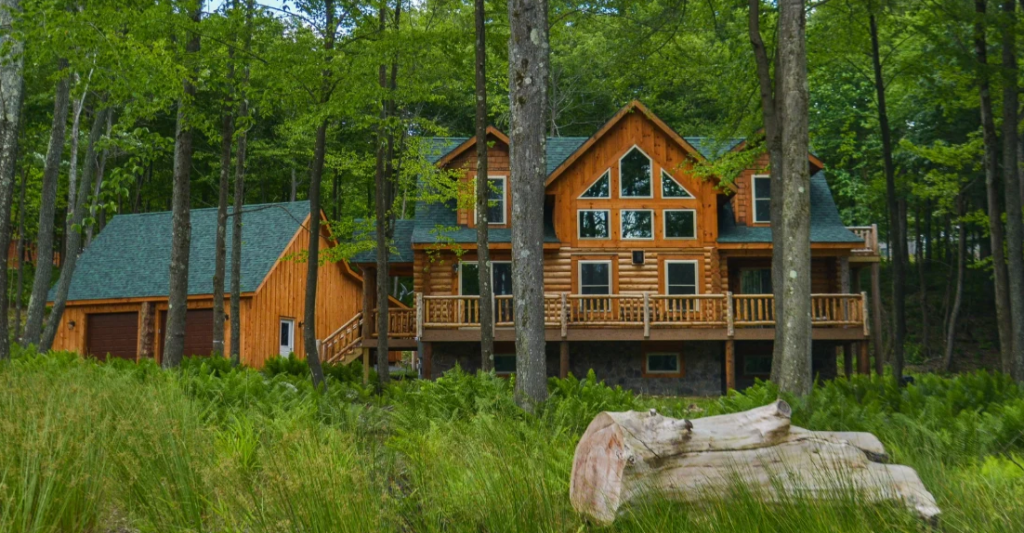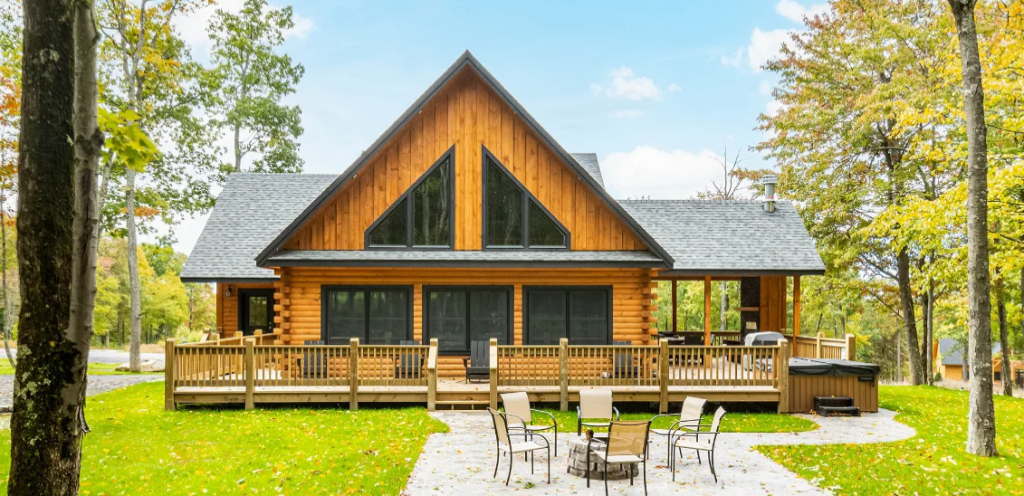Tag: deep creek
Projected Population For Each Maryland County in 2030
The U.S. Census Bureau conducts its decennial national census every 10 year. The census directly shapes federal funding allocations and congressional representation. According to 2020 data, Maryland’s population stands at 6,177,224, ranking it 18th nationally. The state has maintained steady growth of at least 7% per decade, positioning it as the 22nd fastest-growing state relative to population size. Below, we’ve listed Maryland’s 23 counties from smallest to largest projected 2030 population based on current trends.
23. Kent County: 20,900
22. Somerset County: 27,450
21. Garrett County: 30,250
20. Dorchester County: 35,160
19. Caroline County: 37,700
18. Talbot County: 39,650
17. Queen Anne’s County: 56,320
16. Worcester County: 57,150
15. Allegany County: 72,150
14. Calvert County: 97,900
13. Cecil County: 112,050
12. Wicomico County: 115,700
11. St. Mary’s County: 131,260
10: Washington County 164,900
9. Carroll County: 174,150
8. Charles County: 184,470
7. Harford County: 271,860
6. Frederick County: 300,580
5. Howard County: 356,860
4. Anne Arundel: 608,990
3. Baltimore County: 846,590
2. Prince George’s County: 940,960
1. Montgomery County: 1,124,790
Information courtesy of Maryland State Archives
Whats Happening This Week
Garrett County Chamber Of Commerce
April 9 - April 15, 2025   April 9 | 5:30 pm - 6:30 pm Friends of the LibraryOakland Library. Every Second Wednesday of the Month.Love your local library? Want to help shape its programs and future? Become a Friend of the Library and contribute your ideas and talents. Join us to discuss programs and activities you'd like to see. April 9 | 5:30 pm - 6:30 pm Friends of the LibraryOakland Library. Every Second Wednesday of the Month.Love your local library? Want to help shape its programs and future? Become a Friend of the Library and contribute your ideas and talents. Join us to discuss programs and activities you'd like to see. April 10 | 5:00 pm - 7:00 pm April Business After Hours - Pawn Run Bar & Kitchen485 Boy Scout Road, Oakland, MD.The Chamber is pleased to announce that Pawn Run Bar & Kitchen will be hosting our April Business After Hours on Thursday, April 10th from 5:00 pm - 7:00 pm. April 10 | 5:00 pm - 7:00 pm April Business After Hours - Pawn Run Bar & Kitchen485 Boy Scout Road, Oakland, MD.The Chamber is pleased to announce that Pawn Run Bar & Kitchen will be hosting our April Business After Hours on Thursday, April 10th from 5:00 pm - 7:00 pm. Nestled in the mountains and off the beaten path; Pawn Run's vision of a laid back, outdoorsy environment to enjoy craft cocktails, craft beer, wine and signature small plates has come to life. No matter the season, whether you are coming by car, bike or snowmobile - they are happy to have you! They love this land and the roots they have planted along the way. The owners of Pawn Run were presented with an opportunity to revitalize and protect the business and that is just what they did. Their passion for the history of the building has been the driving force behind their mission to keep the good times rolling for the community in this small corner of Maryland! Enjoy delicious food and drinks as you mingle with fellow Chamber members and Chamber staff at our monthly networking events. Don't forget your business card to enter to win prizes. $10.00 in advance for members$15.00 for members at the door and non-membersTo register, click here.  April 10 | 6:00 pm - 8:00 pm Deep Creek Lake-Themed Team Trivia Nights Aces Run Restaurant, Oakland, MD.Test your knowledge of all things Deep Creek Lake with Team Trivia Nights every Thursday evening 6-8pm throughout April at Ace's Run! Food and drink available and there will be prizes, including a cool custom DCL100 award for the winning team each week!Questions will be drawn from our archive and timeline on the website, so study up!More info on the Deep Creek Lake Centennial including more events, projects, an interactive timeline and more available at https://dcl100.com/ April 10 | 6:00 pm - 8:00 pm Deep Creek Lake-Themed Team Trivia Nights Aces Run Restaurant, Oakland, MD.Test your knowledge of all things Deep Creek Lake with Team Trivia Nights every Thursday evening 6-8pm throughout April at Ace's Run! Food and drink available and there will be prizes, including a cool custom DCL100 award for the winning team each week!Questions will be drawn from our archive and timeline on the website, so study up!More info on the Deep Creek Lake Centennial including more events, projects, an interactive timeline and more available at https://dcl100.com/ April 10 | 6:30 pm - 8:30 pm Team Trivia Mountain State Brewing Company, 6690 Sang Run Rd, McHenry, MD.Team Trivia every Thursday, free to play! Contact information: 301-387-3360. April 10 | 6:30 pm - 8:30 pm Team Trivia Mountain State Brewing Company, 6690 Sang Run Rd, McHenry, MD.Team Trivia every Thursday, free to play! Contact information: 301-387-3360.  April 10, 11 & 12 | 7:30 pm Northern Garrett High Theatre Performance of the Little Shop of HorrorsPerforming Arts Center at Garrett College, McHenry, MD.Join the Northern Garrett High School Theatre's production of "Little Shop of Horrors" from April 10th through 12th, at 7:30 pm, at the Performing Arts Center of Garrett College. April 10, 11 & 12 | 7:30 pm Northern Garrett High Theatre Performance of the Little Shop of HorrorsPerforming Arts Center at Garrett College, McHenry, MD.Join the Northern Garrett High School Theatre's production of "Little Shop of Horrors" from April 10th through 12th, at 7:30 pm, at the Performing Arts Center of Garrett College.In a dead-end job in a dead-end shop, Seymour Krelbourn snips the dead ends off of flowers beside his miserly boss, Mr. Mushnik and the love of his life, Audrey Fulquard, wishing that his luck will change. When a strange and unusual plant falls into his lap, Seymour finds his stars realigned! Suddenly, the world revolves around him and this new flytrap that he names Audrey 2. To stay on his winning streak, all Seymour will have to do is keep his precious plant fed… Little Shop of Horrors is a horror comedy musical, at times funny, frightening, and sincere, but always outrageous.Parental discretion is advised for audience members under 13 years of age. Tickets are available at https://garrettarts.org/event-directory/ for $5/each.  April 11 | 4:30 pm - 6:30 pm St. Peter's Fish DinnersSt. Peter the Apostle Catholic Church and Parish Center Hall, 208 S. Fourth St., Oakland, MD.Friday Fish Dinners at St. Peter the Apostle Catholic Parish!Everyone's favorite tradition is back . . . Enjoy a BIG fish dinner with your family and friends at St. Peter's in Oakland, Fridays during Lent (March 7 – April 11). Dine-in and Carry-out meals are available.Prices:$13 adults$6 children (ages 12 and under)$7 fish sandwich onlyMenu and event details can be found at garrettstpeter.com/fishdinners.All are welcome! April 11 | 4:30 pm - 6:30 pm St. Peter's Fish DinnersSt. Peter the Apostle Catholic Church and Parish Center Hall, 208 S. Fourth St., Oakland, MD.Friday Fish Dinners at St. Peter the Apostle Catholic Parish!Everyone's favorite tradition is back . . . Enjoy a BIG fish dinner with your family and friends at St. Peter's in Oakland, Fridays during Lent (March 7 – April 11). Dine-in and Carry-out meals are available.Prices:$13 adults$6 children (ages 12 and under)$7 fish sandwich onlyMenu and event details can be found at garrettstpeter.com/fishdinners.All are welcome! April 12 | 10:00 am - 1:00 pm Spring Farmers Markets by Mountain Fresh Producers AssociationMountain Fresh Pavilion, S 1st St., Oakland, MD.Join us for our spring farmers markets! Our vendors will have fresh produce, meats, eggs, baked goods, jams & jellies, crafts, and personal care items. Want to get updates and product availability lists for the market? Sign up for our weekly email list at mountainfresh.org. April 12 | 10:00 am - 1:00 pm Spring Farmers Markets by Mountain Fresh Producers AssociationMountain Fresh Pavilion, S 1st St., Oakland, MD.Join us for our spring farmers markets! Our vendors will have fresh produce, meats, eggs, baked goods, jams & jellies, crafts, and personal care items. Want to get updates and product availability lists for the market? Sign up for our weekly email list at mountainfresh.org. April 12 | 1:00 pm - 4:00 pm Hat Bar & Caricature Drawings at Cosmic Studios!Cosmic Cheer and Gymnastics, 221 South Third St., Oakland, MD.Join us at Cosmic Studios for Open Gym/Open Play. We will have Medved Farms set up with The Hat Bar offering tons of options to choose from including new summer styles! Our friend the “Silly Goose” Paul Tepper will also be here drawing caricatures! Come join us for a perfect fun filled family Spring Day! April 12 | 1:00 pm - 4:00 pm Hat Bar & Caricature Drawings at Cosmic Studios!Cosmic Cheer and Gymnastics, 221 South Third St., Oakland, MD.Join us at Cosmic Studios for Open Gym/Open Play. We will have Medved Farms set up with The Hat Bar offering tons of options to choose from including new summer styles! Our friend the “Silly Goose” Paul Tepper will also be here drawing caricatures! Come join us for a perfect fun filled family Spring Day! April 13 | 12:00 pm - 3:00 pm Wine Tasting at Smoke N Mirrors114 South 3rd Street, Oakland, MD.Come join us in the Gallery for a free wine tasting, on Sunday, April 13. Wine is available to purchase by the bottle or by the glass and the Tapas menu is available during the tasting. Walk-ins are welcome! April 13 | 12:00 pm - 3:00 pm Wine Tasting at Smoke N Mirrors114 South 3rd Street, Oakland, MD.Come join us in the Gallery for a free wine tasting, on Sunday, April 13. Wine is available to purchase by the bottle or by the glass and the Tapas menu is available during the tasting. Walk-ins are welcome! April 13 | 1:00 pm - 3:00 pm Team BingoMountain State Brewing Company, 6690 Sang Run Road, McHenry, MD.Team Bingo every Sunday at 1pm!Contact information: 301-387-3360. April 13 | 1:00 pm - 3:00 pm Team BingoMountain State Brewing Company, 6690 Sang Run Road, McHenry, MD.Team Bingo every Sunday at 1pm!Contact information: 301-387-3360.  April 13 | 1:00 pm - 5:00 pm Easter Egg-StravaganzaDeep Creek Pottery, 1550 Deep Creek Drive, Suites C & D, McHenry, MD. Join us for a fun and fantastic event! Our Easter Egg-Stravangza is sure to please! Paint Easter Pottery or choose a fun spring mosaic creation! Free crafts after your project and a fun snack bar are sure to please! We will have a face painter from 1:00-3:00 PM. This will be an event not to be missed! See you soon! A $5 entry fee will be charged per family! This is a walk in event! Contact information: 301-501-1619 or deepcreekpottery@gmail.com. April 13 | 1:00 pm - 5:00 pm Easter Egg-StravaganzaDeep Creek Pottery, 1550 Deep Creek Drive, Suites C & D, McHenry, MD. Join us for a fun and fantastic event! Our Easter Egg-Stravangza is sure to please! Paint Easter Pottery or choose a fun spring mosaic creation! Free crafts after your project and a fun snack bar are sure to please! We will have a face painter from 1:00-3:00 PM. This will be an event not to be missed! See you soon! A $5 entry fee will be charged per family! This is a walk in event! Contact information: 301-501-1619 or deepcreekpottery@gmail.com. |
| Garrett County Chamber of Commerce | 15 Visitors Center Drive | McHenry, MD 21541 US |
Big Log Lodge-Vacation Rental In Biltmore At Lodestone
Big Log Lodge is a newly built, charming log home in North Deep Creek Lake, MD, offering a perfect blend of rustic appeal and modern amenities. With 4 bedrooms (each with its own full bath), it comfortably sleeps 12 guests, making it an ideal choice for families or groups of friends. The home features a spacious great room with cathedral ceilings, a gas fireplace, and large windows with scenic woodland views.
Key Features:
Accommodations: 4 bedrooms with queen beds and smart TVs; a queen-size futon in the loft.
Amenities: Private hot tub, sauna, pool table, dart board, and a well-equipped kitchen with stainless appliances.
Outdoor Space: Wrap-around deck, two rear decks, fire pit, and BBQ grill.
Activities: Located near Lodestone Golf Course, Wisp Resort (skiing, tubing, ziplining), and Swallow Falls State Park. Sledding hill available on the property during winter.
Additional Info: A 4WD vehicle is required in winter.
Ideal for a mountain retreat, Big Log Lodge offers both comfort and adventure for an unforgettable vacation experience.
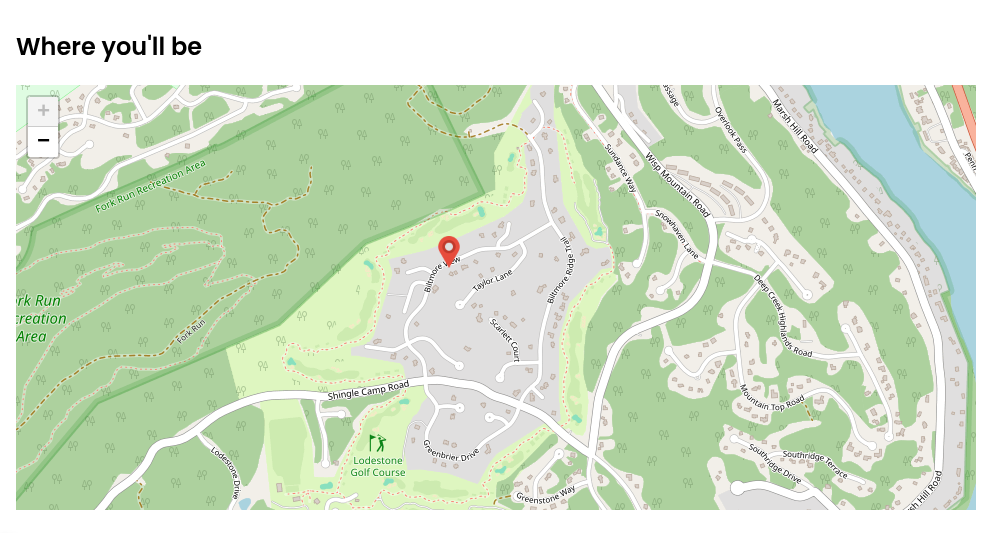


Amenities
View
Wooded View
Location
On Mountain
Lake Area
Golf Course
Ski Area
Pool
Hot Tub - Private
Pet Suitability
No Pets Allowed
Property Features
Air Conditioning
Balcony
Cable/Satellite
Deck
Patio
Fireplace
Iron & Ironing Board
Linens Provided
Pool Table
Wireless Internet
Washing Machine
Grill - Gas
Heating
Carbon Monoxide Detector
Dryer
Smoke Detector
Private Entrance
TV (s)
Fire Extinguisher
Fire Pit
Laptop Friendly
Living Room
No Smoking or Vaping Allowed
Private Sauna
Self Check-in (Keyless Lock)
TV (s) - Smart
Hot Water
Dining Room
Elite
Partial/Mid-Week Stays
Kitchen
Blender
Coffee Maker
Keurig Coffee Maker
Cookware
Dishwasher
Full Kitchen
Ice Maker
Microwave
Oven
Refrigerator
Stove
Toaster
Dishes and Utensils
Mini Fridge
Bathroom
Hair Dryer
Bath Towels Provided
Walk In Shower
Parking
Parking Available - Free
Parking /Access- 4WD Required for Winter
Resort/Shared Amenities
Gated Community
Sauna
Community Lake Access
Fitness Room
Nearby Activities
Boating
Restaurants
Fishing
Golf Course(s)
Miniature Golf
Hiking
Snow Skiing
State Parks
DCL Lakefront Real Estate History Explored
Interested in lakefront property for $500?
No problem – you just need to time travel back to 1925.
Local Realtor Karen Myers explored the history of Deep Creek Lake waterfront lots – including average cost through the years – last Thursday night in a lecture at the Performing Arts Center at Garrett College in front of a packed conference center audience. Myers served as the fourth and final presenter in a month-long lecture series celebrating Deep Creek Lake’s 100th anniversary.
While Myers said you could indeed buy lakefront property for $500 in 1925-35, she also sought to put that in context.
“In 1925, $5,425 was the average income for people with a high enough income to submit a tax return,” said Myers, noting “$5,425 in 1925 had the same buying power as $99,000 in 2024.”
One reason the initial cost of lakefront property was so affordable was the lake’s somewhat murky reputation. Myers said many people simply weren’t impressed with the man-made body of water: “ ‘It’s an artificial lake . . . it’ll never amount to anything,’ ” was a fairly common point of view, according to Myers.
Lakefront prices actually declined over Deep Creek Lake’s first few years in existence. That phenomenon had a clear cause – the Great Depression that started in 1929. Myers highlighted a five-lot parcel that sold for $500 in the 1930s – three of which she and her brother purchased in 2003 for $675,000.
While lots remained relatively affordable for decades – they could still be had for $20,000 to $35,000 in the mid-1970s – Myers said wily developers could still make money with the right deal.
“Eastern Land Corporation sold 1600 acres of land in two tracts for $38,000 in 1938. The buyers re-sold the 400 acres in the second tract that same day for $50,000 – but ‘with no title or interest in the artificial lake or pond,’ ” said Myers, noting both transactions had payment terms over a number of years.
Myers noted that the early lakefront owners lacked a lot of things that 21st-century people would consider basic necessities.
“In the ’30s, the Deep Creek Lake Association reported there were 139 private cottages and 80 cottages for rent. There were also 81 sanitary privies – outhouses – and 52 unsanitary privies,” said Myers, who then asked the question everyone was thinking. “What in the world is an unsanitary privy?”
Some of the biggest changes around the lake have taken place during its second 50 years. Those changes have included the implementation of zoning ordinances and more stringent regulations for onsite septic systems.
“Homesites had to be pre-perked before they could be sold,” Myers said of one significant change.
In the 1980s, under Sanitary Commission Administrator Wendell Beitzel, a sanitary system was created that dealt with a potentially serious problem. Myers said it would have been “a huge black mark if we had septic-contaminated water,” which had become a distinct possibility. The first phases of the Deep Creek Lake sewer system were completed in 1984-86.
Meanwhile, the 26-year project to create Interstate Route 68 transformed Deep Creek Lake into a highly attractive tourist destination.
“In 1990, on the old Route 40, it was normal to take 5½ to six hours to get to Baltimore or Washington. Once 68 opened, that time was cut to about three hours,” said Myers, noting that positioned Deep Creek Lake as a prime vacation option.
“Studies have shown that most people want their vacation destination to be between two and four hours from their home,” Myers said. “After Route 68 opened, we had five of the wealthiest counties in the country less than four hours away.”
Myers summarized the history of lakefront lots in the Deep Creek area, showing the highest lot sale price rising to $1.75 million in 2024 – an increase of nearly 3500 percent in a century.
Talk about a great return on investment!
Notes: Chris Nichols, chair of the Deep Creek Lake 100 Committee, summarized the list of upcoming DCL 100 events. Those events include a day of free admission to Deep Creek Lake State Park and a boat parade on the lake (both June 21); a sailboat regatta (July 5); the DCL 100 Bash festival at the Garrett County Fairgrounds (July 19); and the Deep Creek Lake Centennial Gala at the Wisp Resort with a “Roaring ’20s” theme (August 23). For more information on DCL 100 events, go to https://dcl100.com/events.
Hilltop Hideaway-Vacation Rental In Biltmore at Lodestone
Hilltop Hideaway is a spacious, brand-new 6-bedroom, 5-bathroom vacation home in North Deep Creek Lake, MD, offering a perfect getaway for up to 16 guests. This luxurious property features a private hot tub, modern amenities, and scenic golf views. It’s ideally located near golf courses, Wisp Resort, and Deep Creek Lake State Park, offering a variety of activities such as skiing, hiking, whitewater rafting, and boating.
Key Features:
Accommodations: Sleeps 16, with 5 King bedrooms and a Queen/Queen bunk bed.
Amenities: Private hot tub, pool table, wet bar, gas grill, smart TVs, and a fireplace. No pets allowed.
Outdoor Space: Large patio with outdoor fireplace, ideal for relaxing and enjoying the views.
Proximity: Less than a mile to Lodestone Golf Course and a five-minute drive to Wisp Resort for skiing and other activities. Deep Creek Lake State Park is nearby for summer fun with beach access, canoeing, and hiking.
Important Info: A 4WD vehicle is required in winter. Check-in at 4:00 PM, check-out by 10:00 AM. No pets allowed.
Ideal for family vacations or group trips, Hilltop Hideaway combines relaxation with adventure in a prime location.


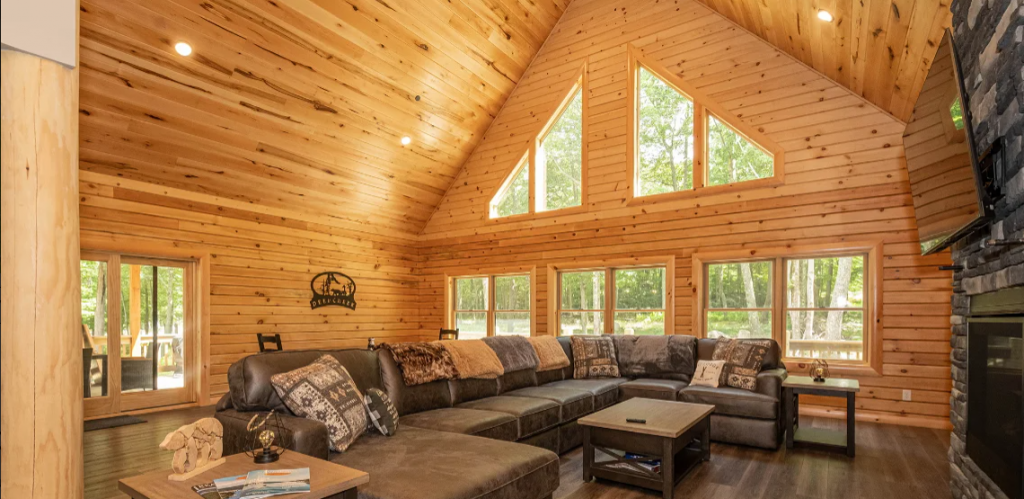
Amenities
View
Golf View
Wooded View
Location
Near Mountain
On Mountain
Lake Area
Golf Course
Ski Area
Pool
Hot Tub - Private
Pet Suitability
No Pets Allowed
Property Features
Air Conditioning
Deck
Patio
Fireplace
Iron & Ironing Board
Linens Provided
Pool Table
Wireless Internet
Wet Bar
Washing Machine
Grill - Gas
Heating
Carbon Monoxide Detector
Dryer
Smoke Detector
Private Entrance
TV (s)
Fire Extinguisher
Fire Pit
Laptop Friendly
Living Room
No Smoking or Vaping Allowed
Self Check-in (Keyless Lock)
TV (s) - Smart
Wine Cooler
Luxury Property
Hot Water
Dining Room
Elite
Partial/Mid-Week Stays
Kitchen
Blender
Coffee Maker
Keurig Coffee Maker
Cookware
Dishwasher
Full Kitchen
Ice Maker
Microwave
Oven
Refrigerator
Stove
Toaster
Dishes and Utensils
Mini Fridge
Bathroom
Jetted Tub
Hair Dryer
Bath Towels Provided
Walk In Shower
Parking
Parking Available - Free
Parking /Access- 4WD Required for Winter
Resort/Shared Amenities
Gated Community
Nearby Activities
Boating
Restaurants
Fishing
Golf Course(s)
Miniature Golf
Hiking
Snow Skiing
State Parks
Whitewater Rafting
This Unique Treehouse Rental is Hidden Away in McHenry, Maryland
Take your getaway to new heights — quite literally — when you book a stay at this picture-perfect treehouse Airbnb near Deep Creek Lake.
Written by
Beth Copenhaver
There's something inherently magical about a treehouse. It harkens back to childhood days and imaginative escapes. If you're looking for a getaway that comes with a heavy dose of whimsy and nostalgia, we invite you to explore Maryland's very own Whispering Woods, a multi-level treehouse hidden away near Deep Creek Lake in McHenry, Maryland. It's a stunning, newly-built cabin wholly enveloped in the woods, offering guests an immersive, secluded stay.
One of the best parts about taking a vacation is the change in scenery. And nothing switches it up quite like sleeping among the treetops. Whether you're a Maryland resident or visiting from out of state, you'll love the chance to move into a real-life treehouse for a few nights. The cabin can comfortably accommodate up to five guests with two bedrooms, three beds, and two baths.
Unlike many treehouse designs, where the space is tight and rustic, Whispering Woods is luxurious. Take some time to explore the interior, and you'll fall in love with the warm wood paneling and ceiling, luxe finishes, and beautiful spiral staircase leading to the second floor. Other top-notch amenities include a fully-stocked kitchen, a living room with a 65-inch TV, and plenty of room to lounge.
One of my favorite features is the use of natural light. Abundant windows offer glimpses of the surrounding trees, and the mountains are also visible in the winter. You'll be staying just a short drive from Maryland's famous Wisp Resort, which offers outdoor activities like skiing and adventure courses year-round.
While the interior is impressive, the outdoor space really sets this place apart from other cabin rentals in the area. Spacious decks, ample seating, and a private hot tub mean you can enjoy being outside even in the middle of winter.
After a day filled with enjoying all that this treehouse has to offer, gather with your crew around the fire pit and enjoy quality conversation under a blanket of stars. It just doesn't get much better! We'll leave you with one recent glowing review that summarizes this stay's many charms: "We had such a great stay here at Whispering Woods! Check-in was easy, everything was super clean, and the house was exactly as pictured. It was very private and peaceful, and we especially loved the cozy loft at the top of the treehouse and using the hot tub every day."
Ready to book your treetop getaway? Visit the official Airbnb page for additional details, including rates, reviews, and reservations.
Looking for even more travel ideas? We've compiled a list of our favorite hotels and resorts in Maryland. We think you'll be packing your bags in no time!
2025 GCBR Home Show Expo
Mar 29 at 11:00AM - 3:00PM
Garrett County Fairground
270 Mosser Road
Ag Hall
McHenry
21541
Family-friendly, free & open to the public! Activities for kids. Food available, proceeds going to Cindy's Fund. Vendors include lenders, landscapers, home inspectors, interior designers & MORE!
The Expo will host an extensive range of businesses – from service providers to lending institutions to home improvement and construction companies – all within Garrett County and the surrounding area. The public will have a chance to meet with local businesses that may be of resource to them and their home needs. This will be an opportunity for businesses to connect and showcase what they have to offer YOU!
Additionally, The Travel Mug trailer will be setup to sell hot and cold beverages.
Cindy's Fund (a local charity on a mission to help cancer patients in Garrett County) will be running concessions from the kitchen with proceeds going to support their mission, and Emalee Dicks will be doing face painting for children for FREE.
Courtesy of Level Acres Landscaping & Nursery from Springs, PA, at least the first 50 children will get to become mini landscapers for a day! Kids will have the opportunity to experience a little piece of landscaping with some added fun, designing and decorating individual planters, and planting a plant to take home and watch grow.
Come to meet with our vendors or just to look around at the boats and hot tubs that will be on display!
Easter at the Airport
The Garrett County Airport is opening its doors for a fun-filled, family-friendly Easter celebration on Saturday, April 12, from 2:00 to 5:00 p.m. This free event, presented in partnership with Taylor-Made Deep Creek Sales, welcomes guests of all ages to enjoy an afternoon of activities, crafts, and sweet treats.
Families can take part in egg coloring with TEAM 1629 Robotics, create paper airplanes from coloring sheets, and snap pictures with the Easter Bunny. Kids will also receive free candy eggs while supplies last. Adding to the excitement, HART for Animals will be on-site with adoptable puppies looking for their forever homes.
The Garrett County Airport invites the community to come out, celebrate the season, and enjoy a unique Easter event in a one-of-a-kind setting.
For more information about the event, please contact Adison Wyer, Garrett County Airport Manager, at 301-746-8599 or awyer@garrettcountymd.gov.
Garrett County Chamber Of Commerce What's Happening In Garrett County
Garrett County Chamber of Commerce
March 19 - March 25, 2025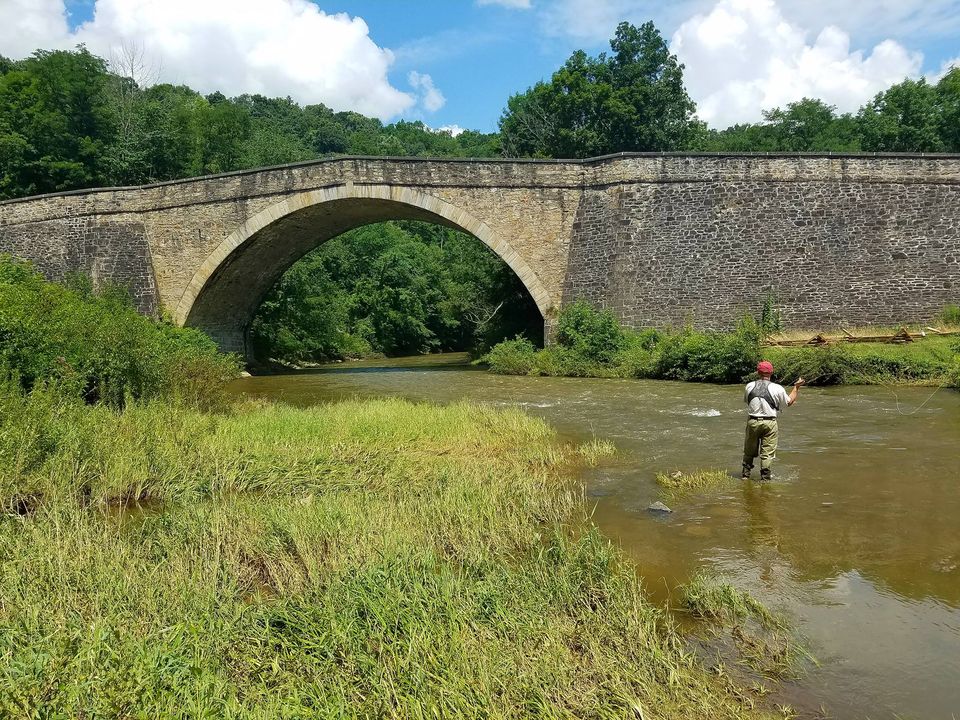 |
 |
 |
March 20 | 5:30 pm - 9:00 pm "Jameson for Your Jigs" Event at Shamrock Whiskey & Cigar Bar624 Humbert School Rd, Rockwood, PA.Enjoy food and drinks from Emerald Isle as Jameson hosts our Irish fest. Sampling & Cocktail Hour begins at 5:30 with Dinner at 6:45pm. Hosted by Shamrock Whiskey & Cigar Bar and Southern Glazers Wine & Spirits.5:30 - 6:30 Irish Whiskey tasting & Cocktail hourEnjoy samples from Jameson, Redbreast, & Green Spot or a Specialty Cocktail created to feature each Irish WhiskeyDinner at 6:45pmIncludes: Irish Pub Salad, Baked Oysters, Braised Beef Short Rib, Plum & Cream CobblerTickets are $75 each which includes dinner, tasting, tax & gratuity.Cash Bar available for anything additional.There will be prizes & giveaways from our Irish Whiskey Sponsors!!Click here for tickets: https://square.link/u/qGmSEO1p |
 |
March 20 | 6:00 pm - 7:00 pm Deep Creek Lake Lecture Series Performing Arts Center at Garrett College, McHenry, MD.Join us for our Deep Creek Lake Lecture Series every Thursday in March 2025, 6pm at the Performing Arts Center at Garrett College. The lecture topics are:-Operation of the Deep Creek Hydroelectric Power Station (Brookfield Renewable)-History of Real Estate around Deep Creek Lake (Karen Myers)-Fishing on and around Deep Creek Lake (TBD)-Wildlife and Habitats of Deep Creek Lake (DNR TBD)Follow us for the exact schedule and more details on each lecture!More info on the Deep Creek Lake Centennial including more events, projects, an interactive timeline and more available at https://dcl100.com/ Free Admission. |
 |
March 20 | 6:00 pm - 8:00 pm Community Pottery ClassDeep Creek Pottery, 1550 Deep Creek Drive, Suites C & D, McHenry, MD.We will offer a series of 5 classes that will include the pinch, coil, slab methods and an introduction to the pottery wheel! Every Thursday evening from 6:00-8:00PM for 5 weeks $200.00 per student includes all glazes and firings! $25.00 registration fee to hold your space! The balance due at the first class! Click on ticket link to pay your registration fee! https://square.link/u/ZpkXCsQg |
 |
March 20 | 6:30 pm - 8:30 pm Team Trivia Mountain State Brewing Company, 6690 Sang Run Rd, McHenry, MD.Team Trivia every Thursday, free to play! Contact information: 301-387-3360. |
 |
March 21 | 6:00 pm Game NightVarious Locations.Join us for Game Night every Friday night at various locations. Starts at 6pmCheck on our Garrett Gamers page on Facebook to see location and information. Free Admission.Contact Information: shepherdDCL@gmail.com. |
 |
March 21 | 4:30 pm - 6:30 pm St. Peter's Fish DinnersSt. Peter the Apostle Catholic Church and Parish Center Hall, 208 S. Fourth St., Oakland, MD.Friday Fish Dinners at St. Peter the Apostle Catholic Parish!Everyone's favorite tradition is back . . . Enjoy a BIG fish dinner with your family and friends at St. Peter's in Oakland, Fridays during Lent (March 7 – April 11). Dine-in and Carry-out meals are available.Prices:$13 adults$6 children (ages 12 and under)$7 fish sandwich onlyMenu and event details can be found at garrettstpeter.com/fishdinners.All are welcome! |
 |
March 23 | 1:00 pm - 3:00 pm Team BingoMountain State Brewing Company, 6690 Sang Run Road, McHenry, MD.Team Bingo every Sunday at 1pm!Contact information: 301-387-3360. |
 |
March 23 | 2:00 pm - 4:00 pm Community Choir Rehearsals ScheduledSt. Mark's Lutheran Church, 2nd Street, Oakland, MD.Community Choir Rehearsals Scheduled.Love to sing? Consider joining the Garrett Choral Society! Spring rehearsal season is underway on Sundays from 2-4pm at St. Mark's Lutheran Church in Oakland. This is our 46th year of presenting vocal music to the community. Feel free to stop by or email garrettchoralsociety@gmail.com for more information. The concert date is May 18 at 3pm in the Performing Arts Center at Garrett College.$20 membership fee. |
 |
March 23 | 4:00 pm California Wine Dinner at Cornucopia146 Casselman Rd, Grantsville, MD.Experience five courses of wines from Gundlach Bunschu led by winemaker Joe Uhr alongside elevated pairings from Chef Martin Galloway, CEC. One of California's oldest wineries, Gundlach Bunschu wines are produced at the prolific intersection of the Sonoma Valley, Carneros, and Napa Valley appellations, and are Regenerative Organic Certified. $125pp plus tax or gratuity, reservations essential with 50% deposit.Visit thecornucopiacafe.com for complete menu details. |
 |
March 24 | 5:00 pm - 6:30 pm "Shamrock Session" Irish Dancing Workshop at Cosmic StudiosCosmic Studios, 221 South Third St., Oakland, MD.Join us for a "Shamrock Session" and learn traditional Irish dancing with Cierra Derato (O'Keefe), a World Championship level Irish dancer, who has competed nationally and internationally over the past twenty plus years. Cierra has performed with renowned names such as Eileen Ivers, O'Malley's March, the Saw Doctors, Lilt, and many more. She's danced at the Kennedy Center, the F. Scott Fitzgerald Theater, and at various Embassy events across Washington, D.C. She brings her love of Irish dance to retirement homes, children's centers, and various other organizations across the DMV. Born into a strong Irish heritage, Cierra loves spreading her passion for Irish dance, culture, and music with audiences around the world. Join us at Cosmic Studios, Monday, March 24th from 5:00 - 6:30 pm for a beginner "Shamrock Session" workshop which will include traditional Irish dance lessons and traditional ceili practice, with drinks and snacks provided for $25! Recommended for ages 12 years and up. |
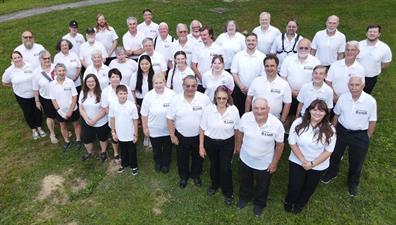 |
March 25 | 7:00 pm - 8:30 pm Community Band Rehearsals Open to New MembersPerforming Arts Center at Garrett College, McHenry, MD.It’s Spring rehearsal season for the Garrett Community Concert Band! Weekly rehearsals are in progress for the upcoming concert on Sunday afternoon, April 27. New players, both young and old, are welcome to join the band. Auditions are not required, but experience playing a band instrument is recommended. Practices are held from 7-8:30 pm on Tuesday evenings in the Recital Hall at Garrett College’s Performing Arts Center. Come give us a try! Email garrettconcertband@gmail.com for more information. |
Deep Creek Lake’s Centennial Celebration
Deep Creek Lake will have its 100th birthday in 2025, and we’ll be celebrating all year long with events and projects throughout the year. Visit dcl100.com for all the latest updates.
Lecture Series Underway
Every Thursday in March, the DCL100 Committee is presenting a lecture at the Performing Arts Center at Garrett College on a different aspect of the lake. We’ve had two great lectures so far and have two more coming up. For our first lecture, Chance Friend – Naturalist with the MD Department of Natural Resources – gave a fantastic presentation on Wildlife and Habitats of Deep Creek Lake. We messed up on recording it (forgot to turn on the mic) BUT, Chance is such a great professional that he’s agreed to record himself doing the presentation. We’ll get that posted when he does!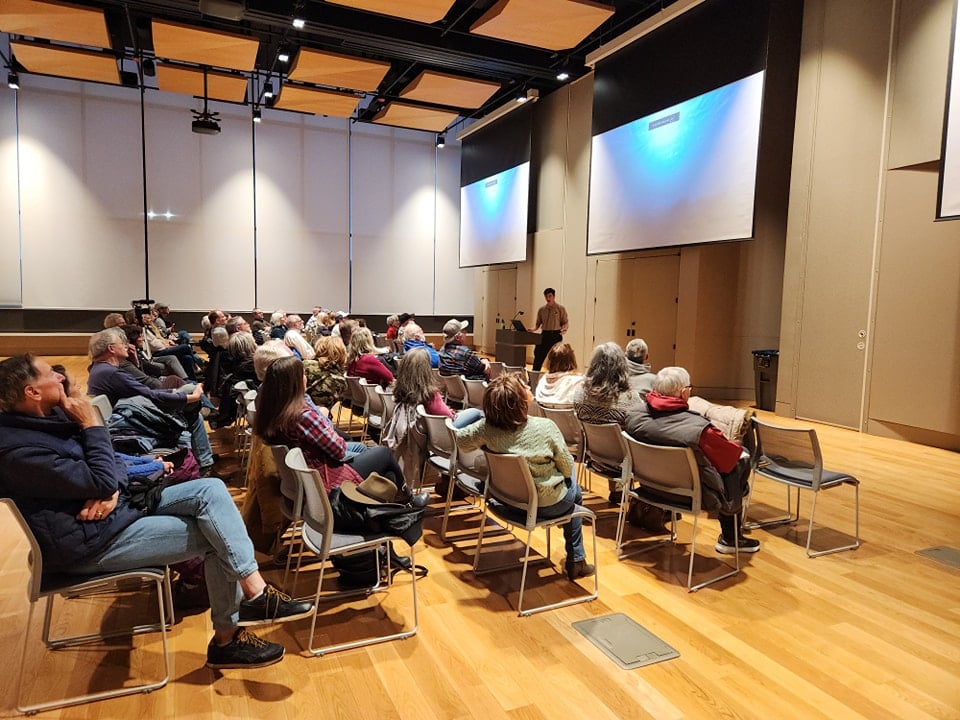
The second speaker, Eric Null – former manager of the Deep Creek Lake Natural Resources Management Area and current Executive Director of Trout Unlimited in Pennsylvania – gave a Master Class on fishing in Deep Creek Lake. If you’re looking to catch some fish in Deep Creek Lake, you need to watch his lecture!
https://youtu.be/TjFFtPKrPug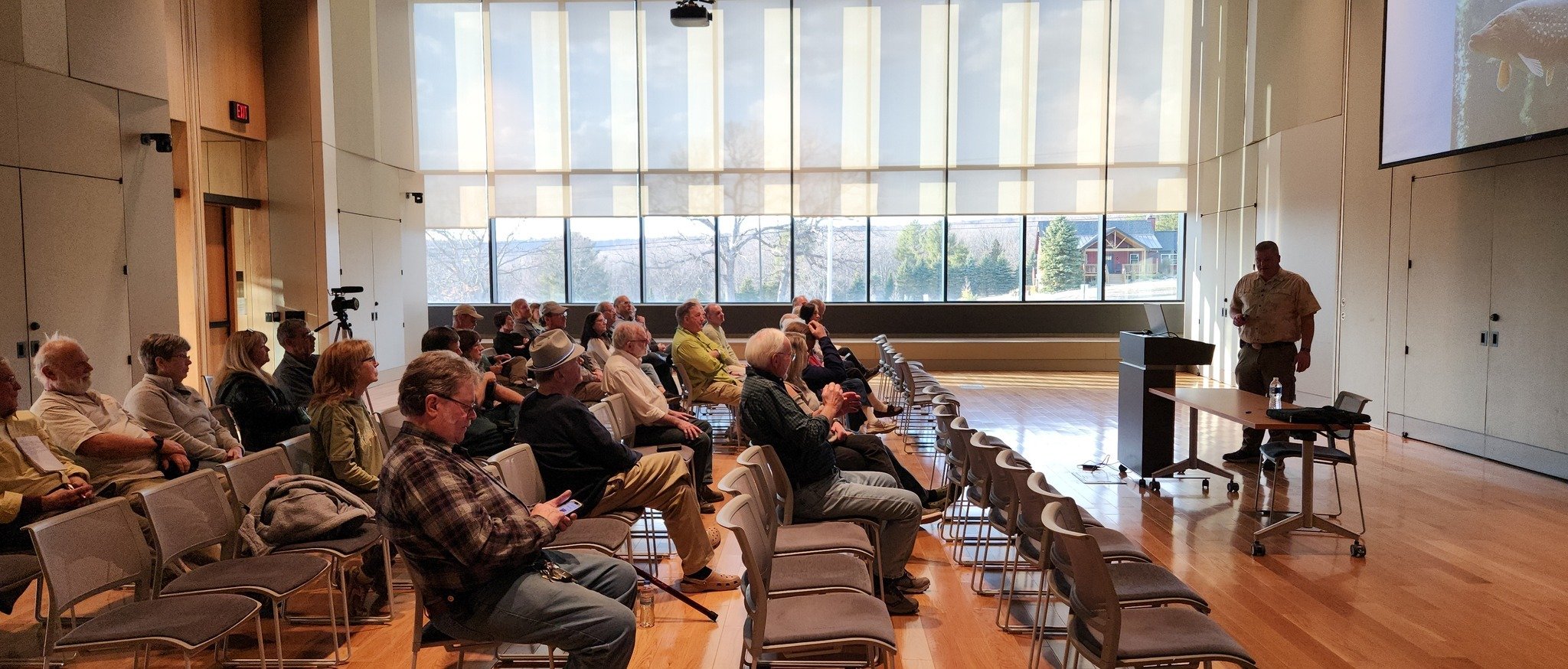
Coming up on March 20th, the operations manager from Brookfield Renewable US will talk about the operation of the dam. If you’ve ever wondered how the power plant makes electricity and where it goes, check out this presentation!And on March 27, Karen Myers will talk about the history of real estate at Deep Creek Lake. She will share her decades of experience to tell us about how some of the well-known property development came to be.The Lecture Series will occur each Thursday in March 2025 at 6pm at the Performing Arts Center at Garrett College. Attendees at the lectures will be able to collect a DCL100 Exploration Ticket and receive the punch for the month of March, and they will be able to enter to win a DCL100 swag pack. The use of the Performing Arts Center and AV support have been generously contributed by Garrett College.
Practice your Swing DanceAre you looking to get ready for the DCL100 Gala? Brush up on your dance moves this month! The Garrett Jazz Ensembles returns for another Swing Dance! Entrance is by donation and will benefit Cindy’s Fund. Refreshments will be available for purchase. Come and dance the night away with Garrett County’s local swing band! Saturday March 29, 6-9pm at the Performing Arts Center at Garrett CollegeTrivia Nights
Local “EMCEE Extraordinaire” Connor Norman will be heading up our DCL Team Trivia Nights every Thursday in April at Ace’s Run starting at 6pm. Each game will have 20 questions and will last about 2 hours. There will be preview questions and answers posted on ours and Connor’s social media the week before the events, so stay tuned to get the heads up!
Entry is free and we’ll provide the trivia trackers, answer sheets, pens etc. Delicious food and drink will be available for purchase at Ace’s. And of course, there will be awesome prizes!
More event news
Earth Day Cleanup – Saturday April 26th – we’ll be partnering with Red Beard Scuba and Recovery for a lake cleanup in celebration of Earth Day. Stay tuned for details!DCL100 Golf Tournament – July 8th at Thousand Acres Golf Course – swing your clubs at the amazing new course at Thousand Acres Golf Club – more details coming soon!Deep Creek Lake 100th Birthday Bash – July 19th at the Fairgrounds-Planning is coming along for the big event of the year – contact our Event Chair Missy Gralish if you would like to volunteer or become involved!Our vendor application is now available! Limited-edition serigraphThe Maryland Park Service has commissioned a limited-edition serigraph print by renowned artist Erick Sahler. This stunning artwork captures the beauty of Deep Creek Lake, featuring a tranquil shoreline at Deep Creek Lake State Park, a fisherman’s boat, and the iconic Glendale Bridge rising in the background.Sahler, an Illustrator Member of the prestigious Society of Illustrators, is known for his vibrant and masterfully crafted serigraphs that reflect the spirit of the mid-Atlantic region. This commemorative piece will soon be available for purchase at the Deep Creek Lake Discovery Center, offering a timeless keepsake for those who cherish the lake. Stay tuned for details on its release or contact the Discovery Center at 301-387-7067.
Full event listing And here’s the full list of events we’ve got on deck – be sure to check the website and our social media for updates!
March 6,13, 20 & 27, 2025—Lecture series about various aspects of Deep Creek Lake @ the Performing Arts Center at Garrett College – each Thursday at 6pm in March (environmental, recreational, proactively working to ensure the health of Deep Creek Lake for the next 100 years and beyond. Facebook event pageApril 3,10,17 & 24, 2025– Deep Creek Lake Team Trivia nights at Ace’s Run – test your DCL knowledge – prizes for winning teams. Facebook event pageApril 27, 2025 – Picture Party at Ace’s Restaurant (hosted by Brenda McDonnell) Facebook event pageApril 29, 2025 – Amazing Grazing – the Taste of Garrett County – DCL100 partnering with Stage WEST at GC Ag HallMay 12, 2025 – FREE Admission to Deep Creek Lake State Park (sponsored by the Western Garrett County State Park Volunteers)May 24, 2025—Deep Creek Lake Adventure Challenge – Based at Wisp Resort, teams will travel around the lake and compete in puzzles, trivia and physical challenges with prizes for teams with the most points! Facebook event pageJune 21, 2025 – FREE Admission to Deep Creek Lake State Park (sponsored by the Western Garrett County State Park Volunteers)June 21, 2025 – Recreation Fair at Deep Creek Lake State Park (sponsored by the Garrett County Health Department’s Population Health, Innovation, and Informatics Unit)June 21, 2025 – Boat parade on Deep Creek Lake – Put on by the Deep Creek Lake Lions Club, the parade will feature entries from all towns, various businesses, individuals and organizations. Facebook event pageJune 27, 2025 –DCL100 parade float in Grantsville Days ParadeJuly 4, 2025 – DCL100 parade float in Accident Homecoming ParadeJuly 5, 2025 – DCL100 Sailboat Regatta on Deep Creek Lake held by the Deep Creek Yacht Racing AssociationJuly 8, 2025 – DCL100 Golf Tournament at Thousand AcresJuly 12 – 13, 2025 – Victorian Chautauqua in Mt Lake Park featuring one or more speaker portrayers with DCL connectionsJuly 19, 2025 – DCL100 Birthday Bash – FREE or low charge entrance to a festival at the Garrett County Fairgrounds—to feature bands & music, a Kidzone, parade, craft & arts displays and sales, food vendors, contests and a special ending surprise (12 noon – 10 pm) Facebook event pageJuly 21, 2025 – FREE Admission to Deep Creek Lake State Park (sponsored by the Western Garrett County State Park Volunteers)July 26, 2025 – DCL100 parade float in Kitzmiller Homecoming ParadeAugust 14, 2025 – FREE Admission to Deep Creek Lake State Park (sponsored by the Western Garrett County State Park Volunteers)August 16, 2025 – DCL 100 parade float in Friendsville Days ParadeAugust 23, 2025 – Deep Creek Lake Centennial Gala – at Wisp Resort – Roaring 20’s theme with Big Band live music—capacity –400 people Facebook event pageSept 6, 2025 – Deep Creek Lake Art and Wine Festival – held by HART for AnimalsSept 7,2025 – Watersports Exhibition on Deep Creek LakeSeptember – end of October – Cove Run Corn Maze will feature a DCL100 themeFor more information on the events during the Centennial, visit dcl100.com or contact deepcreeklakepoa@gmail.com to learn more about sponsoring the celebration, volunteering or sharing photographs, memories or memorabilia.
Our Sponsors
Much thanks to the sponsors of the DCL100!The DCL100 CommitteeThe Deep Creek Lake Centennial Committee, was established in 2023 by the Property Owners’ Association of Deep Creek Lake to celebrate the centennial of the lake in 2025. The DCL100 Committee, comprised of representatives from over 10 organizations, has the mission to celebrate the history of the lake and to promote its protection for the next 100 years and beyond
Follow us!Property Owners’ Association of Deep Creek Lake, IncPO Box 816, McHenry


